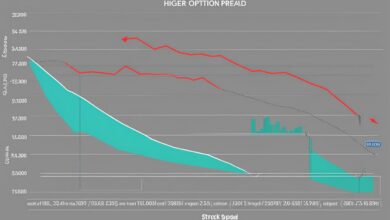The Wheel Strategy For Options Trading: A Cyclical Approach

The options wheel strategy is an income-producing strategy that involves selling put options and potentially owning stock. The goal of the strategy is to consistently generate credit by selling short put options. If assigned shares of stock, the strategy also involves selling covered calls to generate additional income. This strategy is popular among investors looking for a simple transition to options trading and can be a powerful way to maximize trading potential.
Key Takeaways:
- The options wheel strategy focuses on selling put options and covered calls in a cyclical manner
- By following this strategy, investors can generate consistent income
- The options wheel strategy is an ideal approach for investors transitioning to options trading
- It can be tailored to individual market conditions and helps maximize trading potential
- Risks should be evaluated and a risk management plan should be in place before implementing the strategy
Understanding the Options Wheel Strategy
The options wheel strategy is a cyclical approach to options trading that allows investors to generate consistent income. It consists of two main components: selling a cash-secured put option and selling a covered call if assigned stock. By repeating this process, investors can reduce the position’s cost basis and potentially realize a net profit. This strategy is ideal for stock investors looking to generate income and transition to options trading.
The options wheel strategy involves selling a cash-secured put option and a covered call. Selling a cash-secured put option involves selling a put contract and holding enough cash to purchase the stock if the option is exercised. Selling a covered call involves owning the stock and selling a call contract against it. Both of these components generate income through the sale of options contracts and can be repeated in a cyclical manner.
To better understand how the options wheel strategy works, let’s take a closer look at an example:
“Suppose an investor wants to implement the options wheel strategy on a stock trading at $50 per share. They first sell a cash-secured put option with a strike price of $45 and collect a premium of $2. If the option expires worthless, they keep the premium as profit. If the option is exercised, they are obligated to purchase the stock at $45 per share. If assigned the stock, they can then sell a covered call with a strike price of $55 and collect another premium. This process can be repeated, allowing the investor to generate consistent income while potentially reducing the overall cost basis of the stock.”
The options wheel strategy provides a systematic and cyclical approach to income generation in options trading. It allows investors to leverage their existing stock positions to generate additional income through the sale of put options and covered calls. By understanding the mechanics and components of this strategy, investors can take advantage of potential market opportunities while managing risk effectively.

Key Takeaways:
- The options wheel strategy involves selling a cash-secured put option and a covered call to generate income.
- By repeating this process, investors can reduce the position’s cost basis and potentially realize a net profit.
- This strategy is popular among stock investors looking to generate consistent income and transition to options trading.
- The options wheel strategy provides a systematic and cyclical approach to income generation in options trading.
| Advantages | Disadvantages |
|---|---|
| Consistent income generation | High capital requirements |
| Benefit from time decay | Limited upside potential |
| Ability to optimize returns in varying market conditions | Potential for large losses |
The Mechanics of the Options Wheel Strategy
The options wheel strategy is a popular approach for income generation in options trading. To understand the mechanics of this strategy, let’s break it down into its two main components: selling a cash-secured put and selling a covered call.
Selling a Cash-Secured Put
Selling a cash-secured put involves selling a put contract and holding enough cash in your account to cover the purchase of the underlying stock if the option is exercised. When you sell a put, you receive a premium upfront, which is yours to keep regardless of whether the option is exercised or expires worthless.
The cash-secured aspect of this strategy ensures that you have the funds available to buy the stock at the strike price if the put option is exercised. This provides downside protection and mitigates the risk of taking on a position without sufficient capital.
Selling a Covered Call
Once you have sold a cash-secured put and the stock is assigned to your account, you can then sell a covered call. This involves selling a call option against the stock that you own. By selling covered calls, you can generate additional income by collecting the premium from the call option.
When you sell a covered call, you are agreeing to sell the stock at a predetermined price (the strike price) if the option is exercised. If the stock price remains below the strike price, the option will likely expire worthless, allowing you to keep the premium received.
| Strategy Component | Mechanics |
|---|---|
| Selling a Cash-Secured Put | Sell a put contract and hold enough cash to buy the stock if assigned |
| Selling a Covered Call | Sell a call option against the stock you own |
By repeating this process of selling cash-secured puts and covered calls, investors can generate consistent income and potentially profit from both the premiums received and the price movements of the underlying stock. It is important to understand the mechanics of each component and execute the strategy with sound risk management principles in order to maximize its effectiveness.

Executing the options wheel strategy requires discipline and careful analysis of each step. By following the outlined approach and adapting it to your specific goals and risk tolerance, you can effectively generate income and optimize your options trading.
Characteristics of the Options Wheel Strategy
The options wheel strategy possesses several key characteristics that make it an attractive approach for income generation in options trading. Understanding these characteristics is crucial for investors looking to implement this strategy effectively.
Benefitting from Time Decay
One characteristic that sets the options wheel strategy apart is its ability to benefit from time decay. Time decay refers to the gradual reduction in the value of an option as it approaches its expiration date. By selling put options and covered calls, investors can take advantage of this time decay and collect premium over time. This consistent income generation can contribute significantly to the overall profitability of the strategy.
Market Outlook and Flexibility
The success of the options wheel strategy relies on a market outlook that is neutral to slightly bullish. This means that the strategy performs best in markets where stocks are stable or have a gradual upward trend. By capitalizing on these market conditions, investors can optimize their returns and generate consistent income.
Moreover, the options wheel strategy provides investors with flexibility. It can be tailored to individual market conditions, allowing for adjustments as needed. This adaptability makes the strategy suitable for various market environments and enhances its potential effectiveness.
Risk Management and Profit Potential
As with any investment strategy, risk management is essential when implementing the options wheel strategy. While the strategy offers the potential for consistent income generation, it’s important to carefully evaluate the associated risks. These risks include the possibility of significant stock price declines after selling a put option and missing out on potential profits if the stock’s price increases above the strike price of the covered call.
However, when executed with proper risk management techniques, the options wheel strategy has the potential to yield profits. The cyclical nature of the strategy allows investors to reduce cost basis over time and potentially realize a net profit. By understanding and managing these risks effectively, investors can enhance their chances of success with the options wheel strategy.
| Characteristics | Description |
|---|---|
| Benefitting from Time Decay | The options wheel strategy takes advantage of time decay, allowing investors to collect premium over time through the sale of put options and covered calls. |
| Market Outlook and Flexibility | The strategy thrives in markets with a neutral to slightly bullish outlook, and it can be tailored to individual market conditions for optimal performance. |
| Risk Management and Profit Potential | Proper risk management is crucial when implementing the options wheel strategy, as it involves evaluating potential risks and managing them effectively to maximize profit potential. |
Evaluating the Risk Profile of the Options Wheel Strategy
When implementing the options wheel strategy, it is crucial to carefully evaluate its risk profile. By understanding the potential risks associated with cash-secured puts and covered calls, investors can make informed decisions and develop a robust risk management plan.
One potential risk of the options wheel strategy is the possibility of the stock’s price declining significantly after selling a put option. If the stock price drops below the put’s strike price, the investor may be obligated to purchase the stock at a higher price than its current market value.
On the other hand, there is also the risk of missing out on potential profits if the stock’s price increases above the strike price of the covered call. This can limit the upside potential of the strategy, especially if the stock’s price experiences a significant upward movement.
Understanding these risks is essential for investors to effectively manage their positions and adjust their strategies accordingly. By closely monitoring market trends, setting appropriate strike prices, and implementing appropriate risk mitigation techniques, investors can mitigate potential losses and optimize their returns.

Table: Summary of Potential Risks Associated with the Options Wheel Strategy
| Potential Risks | Description |
|---|---|
| Stock Price Decline | The risk of the stock’s price dropping significantly after selling a put option, potentially leading to buying the stock at a higher price than its market value. |
| Missed Profit Opportunities | The risk of missing out on potential profits if the stock’s price increases above the strike price of the covered call, limiting the upside potential. |
| Cyclical Market Volatility | The risk of market volatility impacting the profitability of the strategy, especially during periods of rapid stock price fluctuations. |
| Time Decay | The risk of time decay eroding the value of options contracts, potentially reducing the income generated from selling puts and covered calls. |
| Assignment Risk | The risk of being assigned the obligation to buy or sell the underlying stock, which can result in potential losses or missed profit opportunities. |
It is important for investors to carefully assess their risk tolerance and financial capabilities before implementing the options wheel strategy. By understanding the potential risks involved and having a well-defined risk management plan in place, investors can navigate the market with confidence and optimize their outcomes.
Pros and Cons of the Options Wheel Strategy
The options wheel strategy, like any trading strategy, comes with its own set of advantages and disadvantages. It is important to weigh these pros and cons before deciding to implement the strategy.
Pros of the Options Wheel Strategy
- Consistent income generation: One of the key benefits of the options wheel strategy is its potential to generate consistent income. By selling put options and covered calls, investors can collect premiums over time, leading to a steady stream of cash flow.
- Benefit from time decay: The strategy takes advantage of time decay, as the value of options decreases as they approach expiration. This allows investors to collect premium income while waiting for the options to expire or be assigned.
- Optimize returns in various market conditions: The options wheel strategy can be tailored to different market conditions. Whether the market is neutral, slightly bullish, or experiencing volatility, the strategy provides flexibility to optimize returns.
Cons of the Options Wheel Strategy
- High capital requirements: Implementing the options wheel strategy requires a significant amount of capital. This is because selling cash-secured puts and owning stock for covered calls both involve holding substantial amounts of cash or owning the underlying stock.
- Limited upside potential: The strategy’s focus on generating income means that there is limited upside potential for capital appreciation. While the strategy aims to generate consistent income, it may not be suitable for investors seeking significant capital gains.
- Potential for large losses: Although the options wheel strategy is designed to be a conservative approach to options trading, there is still the potential for substantial losses. If the underlying stock’s price declines significantly or if the stock’s price increases above the strike price of the covered call, losses can occur.
It is important for investors to carefully consider these pros and cons before implementing the options wheel strategy. Assessing one’s risk tolerance, financial goals, and market outlook will help determine if this strategy aligns with individual investment objectives.

| Pros | Cons |
|---|---|
| Consistent income generation | High capital requirements |
| Benefit from time decay | Limited upside potential |
| Opportunity to optimize returns | Potential for large losses |
Understanding Market Conditions for the Options Wheel Strategy
The options wheel strategy is a powerful approach to options trading, but its success is highly dependent on market conditions. Understanding the optimal conditions for implementing this strategy can greatly increase the chances of generating consistent income. Let’s take a closer look at the market conditions that are favorable for the options wheel strategy and those that may pose challenges.
Favorable Market Conditions
Optimal conditions for the options wheel strategy include a neutral to slightly bullish market outlook. This means that stocks should be relatively stable or have a gradual upward trend. In such market conditions, the strategy can thrive as it benefits from the collection of premiums through the sale of put options and covered calls.
In addition to a favorable market outlook, high options liquidity is crucial for executing the strategy effectively. Robust trading activity ensures that there are enough buyers and sellers in the market, allowing for smoother execution of trades. Stocks with low bid-ask spreads also contribute to optimal conditions, as this minimizes the impact of transaction costs.
Challenging Market Conditions
While the options wheel strategy can be highly effective in favorable market conditions, there are certain situations that may pose challenges. High volatility can make it difficult to execute the strategy, as rapid price movements can lead to increased risk and uncertainty.
Rapidly declining stock prices can also be challenging for the options wheel strategy. If the stock’s price falls significantly after selling a put option, there is a risk of potential losses if the option is exercised. It’s important to closely monitor market conditions and have risk management strategies in place to mitigate these challenges.
In summary, understanding market conditions is essential for successful implementation of the options wheel strategy. It is best suited for markets with a neutral to slightly bullish outlook, high options liquidity, and stocks with low bid-ask spreads. However, challenges may arise in highly volatile or rapidly declining markets. By carefully assessing market conditions and adapting the strategy accordingly, investors can maximize their potential returns with the options wheel strategy.

Conclusion
In conclusion, the options wheel strategy offers investors a powerful and systematic approach to options trading, specifically focused on generating consistent income. By selling put options and covered calls in a cyclical manner, investors can aim to reduce cost basis and potentially realize a net profit. However, it’s important to consider the strategy’s risk profile and evaluate individual risk tolerance before implementation.
Comparing with Other Strategies
When comparing the options wheel strategy with other strategies, there are several factors to consider. The options wheel strategy provides a unique combination of income generation and potential capital appreciation through stock ownership. It benefits from time decay and can be tailored to different market conditions, making it a versatile approach.
However, it’s important to note that the options wheel strategy also has limitations. While it offers consistent income generation, it comes with high capital requirements and limited upside potential. Additionally, there is the possibility of incurring large losses if the stock’s price declines significantly.
Ultimately, the suitability of the options wheel strategy will depend on individual goals, risk tolerance, and market outlook. It’s essential to thoroughly understand the strategy, assess market conditions, and carefully weigh the pros and cons before incorporating it into a trading plan. By doing so, investors can make informed decisions and maximize their trading potential.
FAQ
What is the options wheel strategy?
The options wheel strategy is an income-producing strategy that involves selling put options and potentially owning stock. It allows investors to consistently generate credit by selling short put options and can be a powerful way to maximize trading potential.
How does the options wheel strategy work?
The options wheel strategy involves selling a cash-secured put option and a covered call. Selling a cash-secured put option involves selling a put contract and holding enough cash to purchase the stock if the option is exercised. Selling a covered call involves owning the stock and selling a call contract against it. Both components generate income through the sale of options contracts and can be repeated in a cyclical manner.
What is the step-by-step approach for executing the options wheel strategy?
The options wheel strategy can be executed by selling a cash-secured put option, collecting the premium, and then waiting for expiration or assignment. If the put option is assigned, the investor can sell covered calls against the stock. This process can be repeated as long as the investor wants to hold the underlying stock or until the call option is assigned. This cyclical approach allows for consistent income generation.
What are the characteristics of the options wheel strategy?
The options wheel strategy benefits from time decay and is best suited for a market outlook that is neutral to slightly bullish. It provides a way to generate consistent income and can be tailored to individual market conditions.
What are the risks associated with the options wheel strategy?
Some potential risks of the options wheel strategy include the possibility of the stock’s price declining significantly after selling a put and missing out on potential profits if the stock’s price increases above the strike price of the covered call. It’s important to evaluate these risks and have a risk management plan in place before implementing the strategy.
What are the pros and cons of the options wheel strategy?
Some pros of the options wheel strategy include the potential for consistent income generation, the ability to benefit from time decay, and the opportunity to optimize returns in varying market conditions. However, there are also cons to consider, such as the high capital requirements, limited upside potential, and the potential for large losses. It’s important to weigh these pros and cons before deciding to implement the strategy.
How does the options wheel strategy generate income?
The options wheel strategy primarily focuses on generating income through the sale of put options and covered calls. Investors can collect premiums from these options contracts and potentially earn additional income through dividends if they own dividend-paying stocks.
What market conditions are best suited for the options wheel strategy?
The options wheel strategy thrives in markets with a neutral to slightly bullish outlook, where stocks are stable or have a gradual upward trend. Optimal conditions include high options liquidity, robust trading activity, and stocks with low bid-ask spreads. However, there may be market conditions that pose challenges, such as high volatility or rapidly declining stock prices. It’s important to consider these market conditions when implementing the strategy.
What is the overall value of the options wheel strategy?
The options wheel strategy is a powerful approach to options trading that allows investors to generate consistent income. By reducing cost basis and potentially realizing a net profit, it can be a valuable strategy for maximizing trading potential. When comparing it with other strategies, it’s important to consider individual risk tolerance, market outlook, and desired income generation.







